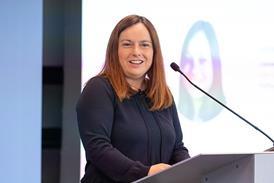In the third instalment of Pensions Expert’s ‘Dear Pension Commission’ series, Retirement Income Taskforce chair Margaret Snowdon outlines her ideas for changing the state pension, auto-enrolment, and contribution rates to better serve more people.
Dear Pensions Commission…
Thank you for accepting the challenge to improve retirement income adequacy for future retirees, with a focus on affordability, sustainability, and equity.
“This is not a task for the faint-hearted, but it is a once-in-a-generation opportunity to rethink what pensions are for and address some of the things that are no longer fit for purpose.”
Margaret Snowdon
This is not a task for the faint-hearted, but it is a once-in-a-generation opportunity to rethink what pensions are for and address some of the things that are no longer fit for purpose.
It is therefore an opportunity to think the unthinkable, to step beyond the boundaries and set out options and choices for government and society. Nothing is impossible until we decide it is. People must believe in the purpose of saving, feel part of it and derive value from it, if we truly want to change the culture of living for the moment.
To that end, I would urge you to consider the following thoughts.
Boosting the state pension and overhauling tax relief

The new state pension is described as a “foundation”, not a living wage, meaning that for everyone, alternative sources of income will be required, either through state supplementation or private saving. This is well-meaning but creates a perverse disincentive to save.
A higher, real living-wage level of state pension would give the certainty of support for lower-paid people and help deal with inequality at retirement suffered by certain groups. Those who want, and can afford, a higher standard of income in retirement should save for it privately.
This has an implication for taxation, which is beyond the scope of the review, but the cost of tax relief on contributions could be funded by a much simpler and lower tax incentive scheme available to those who save through a private pension.
The tax system restricts both the amounts that can be saved into a pension and the amounts that can be taken out. This sends the wrong signals about the need to save.
Tax relief should not be the tail wagging the dog, but an encouragement to save a minimum amount to improve personal outcomes in later life. It could be a fixed percentage up to a certain flat level of contribution.
The elephant in the room is tax-free cash at retirement, with all the regulatory hoops that this entails. If we truly believe that the purpose of retirement saving is to provide an income, providing a tax-beneficial cash alternative makes no sense. There should be a break with this for future savers – although this is difficult to achieve for current savers, as it would be seen as a breach of trust.
Flexible contributions to create a savings culture

Many of the people who need to save the most do not have the disposable income to pay into a pension that they will not see for 45 years or more.
Real wages are only now at the level they were in 2005, with the very obvious exception of executive remuneration. In low-pay cases, encouraging greater saving for retirement will clash with the complex benefits system, leading to the potential for misselling accusations later.
A flexible approach to contributions, rather than a fixed percentage for decades, combined with limited early access to funds to fit in with life circumstances, could make a difference in creating a savings culture.
Another consideration is the shape of retirement. Many people retire earlier due to health issues, while many continue working but at reduced hours.
A flexible state pension would be a useful alternative to a one-size-fits-all that is dependent on age, and would avoid the cliff-edge and dependency on state supplements.
Improving auto-enrolment and DC savings
Auto-enrolment into private savings excludes self-employed and gig workers. This is wrong-headed.
Self-employed and gig workers should be subject to the same requirements as employed workers. The method of collection could be via the tax system.
With defined contribution and auto-enrolment, there is a transfer of risk to individuals. However, those individuals often lack the ability to understand and manage that risk and to make sound decisions on retirement income.

Guidance and financial education for retirement is essential from at least the age of 50, and a base level should be free and provided by the Money and Pensions Service. Employers could assist with ensuring workers receive this guidance at the right time.
Often, we assume that all default funds are the same, yet the difference in real outcomes between the best and the worst is significant. We therefore need a trusted and impartial database of net returns on default funds so that employers and individual savers can see what they are buying.
The role of pensions dashboards
The Pension Commission’s objective is to improve retirement income adequacy. Since the introduction of pension freedoms, we have encouraged savers to take cash rather than income and express DC savings as “pots”.
A pot looks attractive, but it is misleading, so it should be shown as income with easy ways to secure that income.
Technology can already show projected income, gaps, and remedies, but such tools need to be comprehensive and accessible to everyone. Pension dashboards will help with the pension saving component, but the real benefit will come from financial dashboards that capture all of an individual’s savings, assets, and debts and help them navigate a path to a more comfortable and predictable retirement.
We want everyone to be able to thrive in retirement, to continue supporting the economy and feel confident about the benefits of saving for the future.
Margaret Snowdon is chair of the Retirement Income Taskforce and president of the Pensions Administration Standards Association.
‘Dear Pensions Commission…’: Exploring the future of retirement adequacy
- 1
- 2
- 3
- 4
- 5
 Currently reading
Currently readingMargaret Snowdon: A once-in-a-generation opportunity to reshape retirement saving
- 6
- 7
- 8
- 9
- 10





























